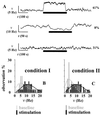Cerebral energetics and spiking frequency: the neurophysiological basis of fMRI
- PMID: 12134056
- PMCID: PMC125038
- DOI: 10.1073/pnas.132272199
Cerebral energetics and spiking frequency: the neurophysiological basis of fMRI
Abstract
Functional MRI (fMRI) is widely assumed to measure neuronal activity, but no satisfactory mechanism for this linkage has been identified. Here we derived the changes in the energetic component from the blood oxygenation level-dependent (BOLD) fMRI signal and related it to changes in the neuronal spiking frequency in the activated voxels. Extracellular recordings were used to measure changes in cerebral spiking frequency (Deltanu/nu) of a neuronal ensemble during forepaw stimulation in the alpha-chloralose anesthetized rat. Under the same conditions localized changes in brain energy metabolism (DeltaCMR(O2)/CMR(O2)) were obtained from BOLD fMRI data in conjunction with measured changes in cerebral blood flow (DeltaCBF/CBF), cerebral blood volume (DeltaCBV/CBV), and transverse relaxation rates of tissue water (T(2)(*) and T(2)) by MRI methods at 7T. On stimulation from two different depths of anesthesia DeltaCMR(O2)/CMR(O2) approximately Deltanu/nu. Previous (13)C magnetic resonance spectroscopy studies, under similar conditions, had shown that DeltaCMR(O2)/CMR(O2) was proportional to changes in glutamatergic neurotransmitter flux (DeltaV(cyc)/V(cyc)). These combined results show that DeltaCMR(O2)/CMR(O2) approximately DeltaV(cyc)/V(cyc) approximately Deltanu/nu, thereby relating the energetic basis of brain activity to neuronal spiking frequency and neurotransmitter flux. Because DeltaCMR(O2)/CMR(O2) had the same high spatial and temporal resolutions of the fMRI signal, these results show how BOLD imaging, when converted to DeltaCMR(O2)/CMR(O2), responds to localized changes in neuronal spike frequency.
Figures




Comment in
-
Appraising the brain's energy budget.Proc Natl Acad Sci U S A. 2002 Aug 6;99(16):10237-9. doi: 10.1073/pnas.172399499. Epub 2002 Jul 29. Proc Natl Acad Sci U S A. 2002. PMID: 12149485 Free PMC article. Review. No abstract available.
References
-
- Sokoloff L. (1993) Dev. Neurosci. 15, 194-206. - PubMed
-
- Siesjo B. K., (1978) Brain Energy Metabolism (Wiley, New York).
Publication types
MeSH terms
Substances
Grants and funding
LinkOut - more resources
Full Text Sources
Research Materials

